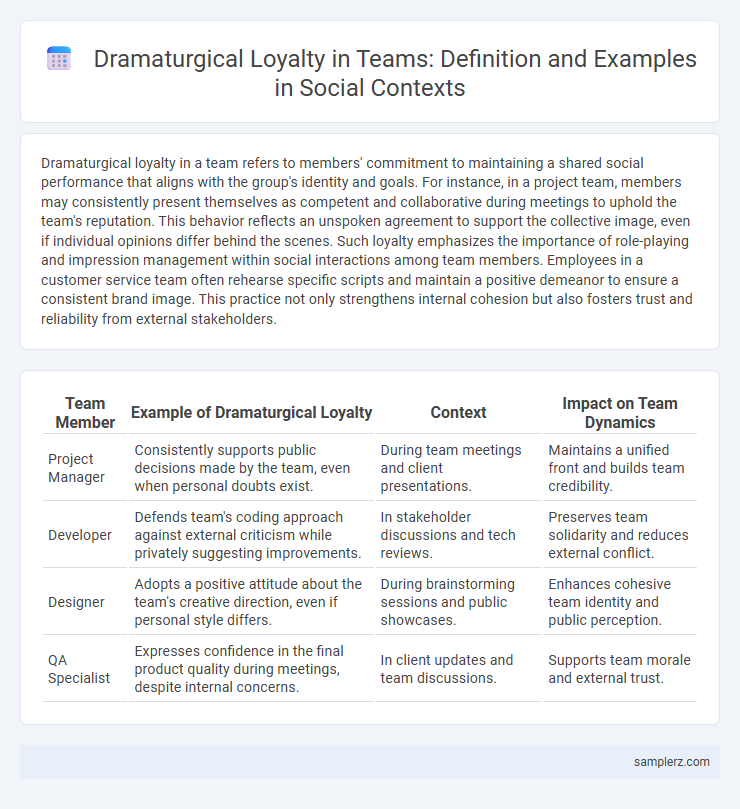Dramaturgical loyalty in a team refers to members' commitment to maintaining a shared social performance that aligns with the group's identity and goals. For instance, in a project team, members may consistently present themselves as competent and collaborative during meetings to uphold the team's reputation. This behavior reflects an unspoken agreement to support the collective image, even if individual opinions differ behind the scenes. Such loyalty emphasizes the importance of role-playing and impression management within social interactions among team members. Employees in a customer service team often rehearse specific scripts and maintain a positive demeanor to ensure a consistent brand image. This practice not only strengthens internal cohesion but also fosters trust and reliability from external stakeholders.
Table of Comparison
| Team Member | Example of Dramaturgical Loyalty | Context | Impact on Team Dynamics |
|---|---|---|---|
| Project Manager | Consistently supports public decisions made by the team, even when personal doubts exist. | During team meetings and client presentations. | Maintains a unified front and builds team credibility. |
| Developer | Defends team's coding approach against external criticism while privately suggesting improvements. | In stakeholder discussions and tech reviews. | Preserves team solidarity and reduces external conflict. |
| Designer | Adopts a positive attitude about the team's creative direction, even if personal style differs. | During brainstorming sessions and public showcases. | Enhances cohesive team identity and public perception. |
| QA Specialist | Expresses confidence in the final product quality during meetings, despite internal concerns. | In client updates and team discussions. | Supports team morale and external trust. |
Defining Dramaturgical Loyalty in Team Settings
Dramaturgical loyalty in team settings refers to the commitment individuals show by performing expected roles and maintaining a consistent identity that aligns with group norms and goals. This loyalty manifests through intentional behaviors like supporting team narratives and preserving group cohesion during interactions. Such alignment enhances trust and cooperation, ultimately driving collective success and positive social dynamics within the team.
Everyday Examples of Dramaturgical Loyalty at Work
Dramaturgical loyalty in a team setting is demonstrated when employees consistently support each other's professional identities by carefully managing impressions during meetings and collaborative projects. For example, team members may avoid publicly criticizing a colleague's ideas, thereby maintaining a cohesive front that aligns with shared workplace values and goals. This loyalty helps sustain trust and group solidarity, ensuring that individual actions reinforce the collective narrative of competence and cooperation.
Navigating Team Dynamics Through Dramaturgical Loyalty
Dramaturgical loyalty in team settings manifests when members consistently uphold shared roles and narratives to maintain group cohesion, such as a project leader subtly reinforcing team values during high-pressure meetings. This loyalty involves managing impressions and sustaining performance scripts that align individual actions with collective goals, promoting trust and mutual respect. Understanding these dynamics enables teams to navigate conflicts and adapt to change without compromising their social identity.
Expressions of Commitment Among Team Members
Dramaturgical loyalty in teams is exemplified by consistent verbal affirmations and supportive body language that reinforce mutual dedication to shared goals. Team members demonstrate commitment through active listening, maintaining eye contact, and using inclusive language that strengthens trust and solidarity. These expressions foster a cohesive group identity, enhancing overall collaboration and performance.
Protecting Team Image: Case Studies in Loyalty
Dramaturgical loyalty in teams manifests when members consistently protect the collective image by managing impressions during conflicts or crises, such as in the 2010 Toyota recall, where employees upheld brand reputation through unified communication. In sports teams like the New England Patriots, loyalty is evident as players prioritize team cohesion over individual errors, maintaining a positive public image despite challenges. These cases illustrate how dramaturgical loyalty fosters trust and solidarity by aligning personal actions with the team's desired social narrative.
Nonverbal Cues as Signs of Dramaturgical Loyalty
Nonverbal cues such as consistent eye contact, synchronized gestures, and mirroring body language serve as powerful signs of dramaturgical loyalty within teams. These subtle behaviors reinforce group cohesion by signaling attentiveness, trust, and unspoken agreement among team members. Observing patterns like nodding in unison or maintaining open postures can reveal the underlying commitment to shared roles and collective identity in team dynamics.
The Impact of Dramaturgical Loyalty on Team Cohesion
Dramaturgical loyalty in teams manifests when members consistently align their roles and performances with shared norms and expectations, reinforcing trust and predictability. This unwavering commitment to the "team script" enhances cohesion by minimizing conflicts and promoting seamless collaboration. Empirical studies demonstrate that higher dramaturgical loyalty correlates with increased group stability and collective efficacy, driving superior team outcomes.
Authenticity vs. Performance in Team Loyalty
Dramaturgical loyalty in teams manifests when members balance authenticity with performance, maintaining genuine commitment while managing impressions to foster trust and cohesion. This blend of sincere dedication and strategic role-playing enhances team loyalty by aligning personal values with collective goals. Authentic interactions grounded in trust reduce conflicts, while performative behaviors ensure adaptability and professionalism in diverse social dynamics.
Challenges to Dramaturgical Loyalty in Modern Teams
Dramaturgical loyalty in modern teams faces challenges such as conflicting individual roles and diverse cultural backgrounds that complicate unified group identity. The rise of remote work also disrupts consistent performance and impression management, leading to fragmented team narratives. Maintaining dramaturgical loyalty requires deliberate efforts in communication strategies and reinforcing shared values to overcome these obstacles.
Enhancing Team Trust Through Dramaturgical Loyalty
Dramaturgical loyalty in a team manifests when members consistently uphold shared narratives and roles, reinforcing trust through predictable and authentic interactions. Commitment to these collective performances fosters psychological safety, enabling open communication and collaboration. This loyalty enhances cohesion by aligning individual behaviors with the team's values and mission, strengthening overall social bonds.

example of dramaturgical loyalty in team Infographic
 samplerz.com
samplerz.com